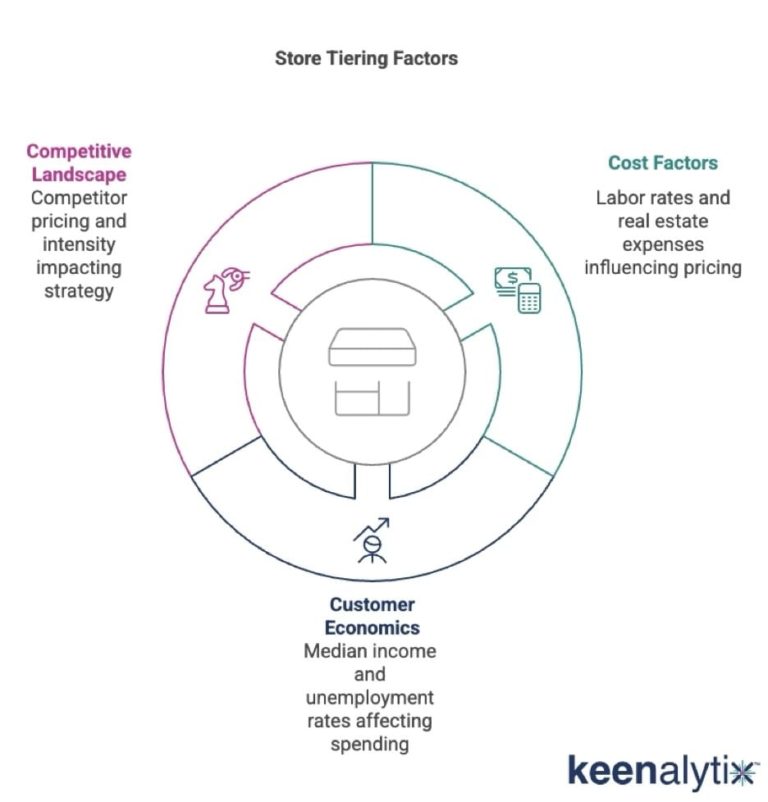For multi-location operators—especially in the restaurant sector—pricing is always a tightrope walk.
On one side: the need for brand consistency. Customers expect fairness and transparency. Too much price variation, and you risk eroding trust.
On the other: harsh regional realities. Labor costs vary dramatically by city. Real estate rates swing wildly. Income levels, spending power, and competitive intensity all change from one ZIP code to the next.
And now, with new tariffs rolling in, the margin pressure is back—sharper than ever.
So how do smart operators manage pricing across 50, 500, or 5,000 locations?
The answer: store tiering.
What is Store Tiering?
Store tiering is a pricing strategy that groups locations into tiers based on local market conditions. Each tier has a distinct pricing guideline—wide enough to reflect local differences, narrow enough to preserve brand coherence.
Instead of trying to calculate prices store-by-store or applying one national price to all, tiering offers a structured middle ground.
Callout: Store tiering = strategic consistency.
Enough variation to match the market. Enough structure to avoid chaos.

Why Tiering Works
Three factors typically drive local pricing differences:
- Cost structures – Labor rates, rent, and distribution costs.
- Customer economics – Household income, employment, and price sensitivity.
- Competitive landscape – Who else is nearby, and what are they charging?
These inputs can be translated into store tiers using various pricing analytics techniques such as simple scoring models or basic clustering techniques. Once assigned, each store operates within a pricing range that reflects its tier.
Callout: In one case study, a regional restaurant chain recovered 90–120 basis points of margin using a 3-tier price structure—with no measurable impact on traffic.

Implementation: Start Simple
If you’re new to tiering, don’t overengineer. Complexity kills momentum.
Start with:
- 2–3 tiers based on clear, measurable inputs
- A basic scoring rule (e.g., High/Medium/Low markets)
- POS readiness for tiered pricing
- A 90-day test-and-learn cycle
Callout: Tools needed: Census data, wage benchmarks, competitor pricing (web scraping works), and internal cost models.
This isn’t an overnight switch. But once in place, the structure gives you pricing flexibility without store-level improvisation.
Benefits: Margin, Discipline, Agility
Here’s what tiering delivers:
- Margin protection – price where you need to, not where you can.
- Brand discipline – a unified structure, not a free-for-all.
- Operational agility – adapt to cost shocks (like tariffs) without blanket hikes.
Callout: Tiering isn’t dynamic pricing.
It’s strategic zoning—a long-term, controlled pricing architecture.
Retailers, convenience chains, and even distributors are now adopting similar approaches, especially where delivery zones or regional warehousing create cost variance.
Don’t Confuse Uniformity with Fairness
One of the oldest myths in pricing is that “uniform = fair.” But fairness isn’t about sameness. It’s about alignment—between cost to serve, customer willingness to pay, and local competition.
Tiering lets you strike that balance:
- Fair to the brand
- Fair to the market
- Fair to the bottom line
Final Word
In a world of tariffs, wage pressure, and local competition, price precision is a strategic asset.
Store tiering won’t solve everything. But it gives you the control to respond smartly—balancing consistency with local reality.
Start small. Stay structured. Learn fast.
Because pricing isn’t just about numbers.
It’s about navigating complexity with confidence.



